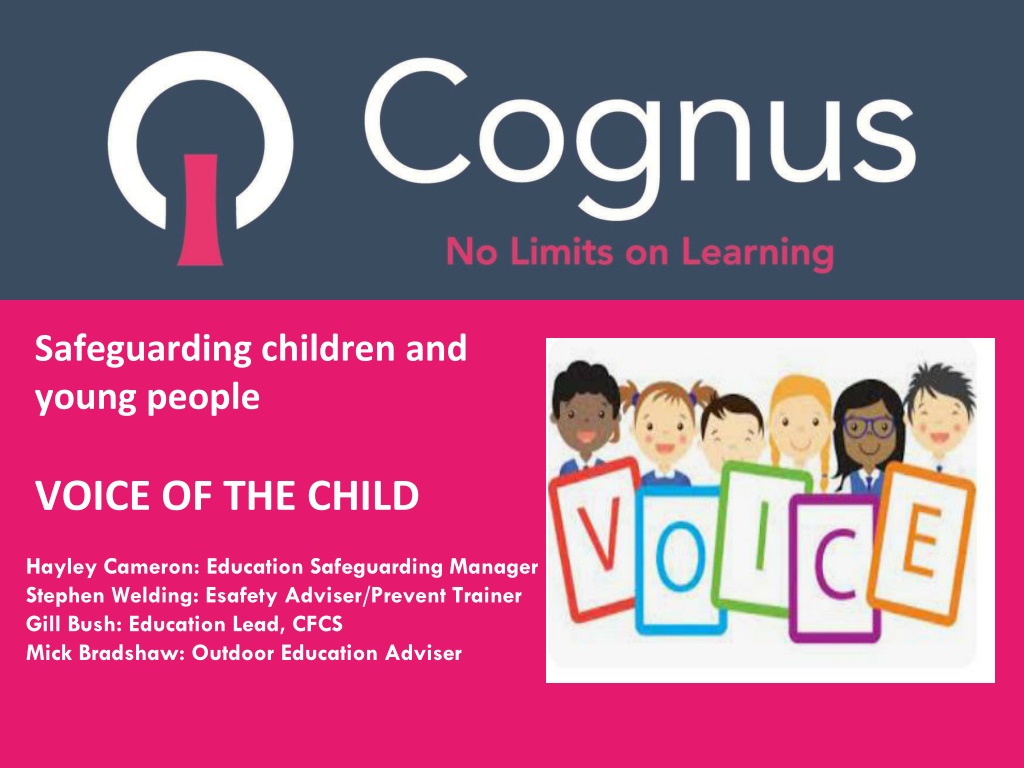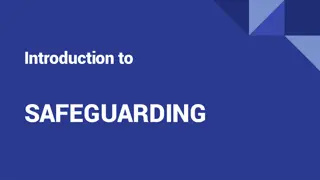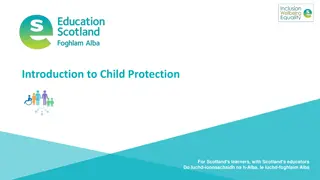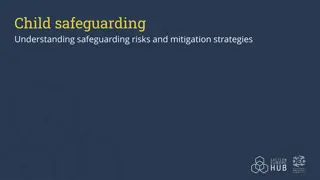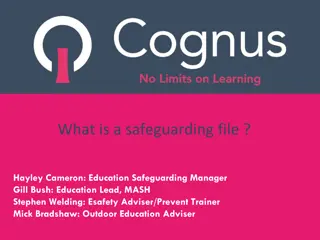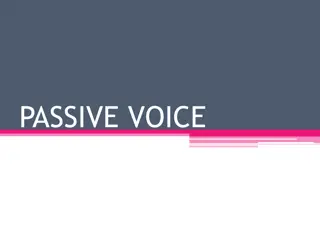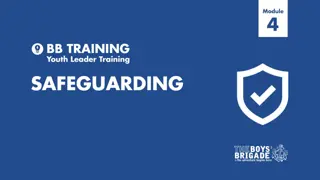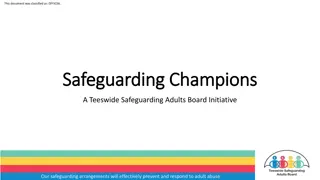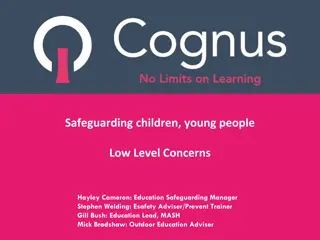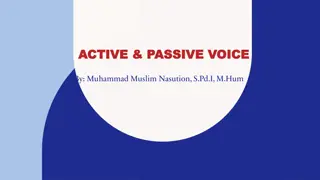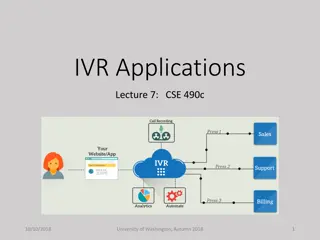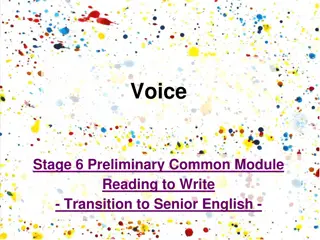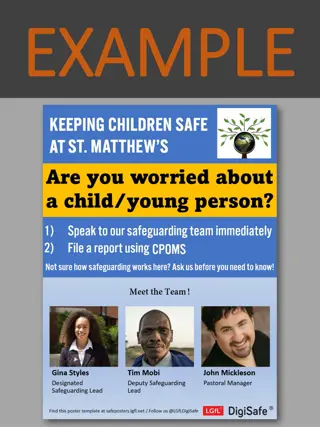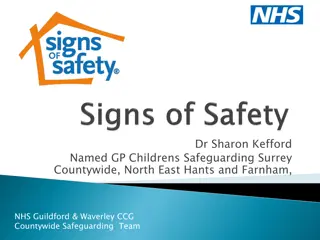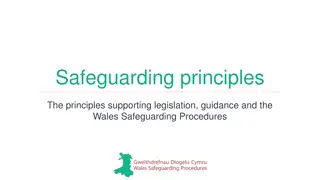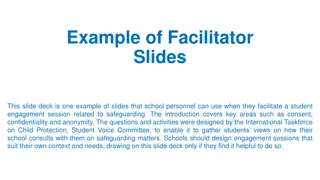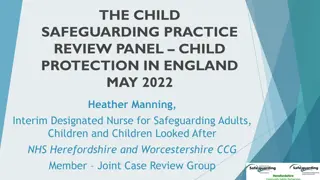Safeguarding Children and Young People - The Voice of the Child
Safeguarding children involves recognizing, recording, reporting, and referring any signs of abuse. The voice of the child is crucial in these situations, and professionals must use open-ended questions to communicate effectively and gather information. Understanding how to recognize signs of abuse and engaging in conversations with children in their own words are essential steps in protecting their well-being.
Download Presentation

Please find below an Image/Link to download the presentation.
The content on the website is provided AS IS for your information and personal use only. It may not be sold, licensed, or shared on other websites without obtaining consent from the author. Download presentation by click this link. If you encounter any issues during the download, it is possible that the publisher has removed the file from their server.
E N D
Presentation Transcript
Safeguarding children and young people VOICE OF THE CHILD Hayley Cameron: Education Safeguarding Manager Stephen Welding: Esafety Adviser/Prevent Trainer Gill Bush: Education Lead, CFCS Mick Bradshaw: Outdoor Education Adviser
Voice of the Child The 4Rs of Safeguarding Children. Recognise Record Report Refer The Voice of the child in the situation of child abuse.
RECOGNISE Interviewing a child/young person should be done carefully and sensitively by professionals who are trained and skilled in this practise and usually Police and Social Workers. In Education children /young people often come to us to discuss concerns and we are often the first point of contact for disclosures. Listening to their voice and allowing them to talk freely without interruption but also obtaining clarity in order that any possible risks be identified and help to make a decision on any possible next steps. These conversations with the child are very important as they help identify the circumstances as much as possible in their own words so the right decisions for child and families can be made at the earliest opportunity.
How do we do this? Open questions should always be used as much as possible. They help to paint a picture and gain information from a child in his or her own words. They are open ended and often start with words like why, how, what, or when. Closed questions should be avoided where possible. These are questions that can be answered with either yes or no or where you give a possible answer or options of answers along with the question. Example: was it Mum or Dad rather than who did that or who said that We always want the voice of the child in their own words and not ours. Remember Describe what you see including any marks, note the child s reaction, behaviour and demeanour as this can often also help with that important picture. Bearing all this mind, ask yourself what is it that I need to clarify and how can I do this being mindful of this and importantly in the child s own words
T.E.D. If a student makes a disclosure but it did not really make sense to you, then you have to ask open questions in order to put some context into what the student is disclosing. My mum hurt me last night
T.E.D. T Tell me what you mean by that E Explain what you mean by that D Describe what you mean by that
Examples of Additional Open Questions Tell me what happened Show me what happened What do you mean Describe to me. When did this happen Then what happened. How do you feel. How did you do that. Why did you do that Why did they do that How can we find out What made you think that Why do you think that happened.
RECORD Note your conversation as factual as possible using the child s words not yours. Describe what you saw including child s demeanour. Date, time and sign your notes. Note in the child s Safeguarding File and if they don t have one create one. Remember we never make promises to a child on any possible next steps following any disclosure.
REPORT and REFER Once we have unpicked and obtained clarity the below should be borne in mind when calling for advice or making a referral to CFCS or in some circumstances calling the Police. Has the child made any disclosures before. Remember to check any safeguarding file for concerns from previous education provision. If there is a sibling are we aware if they have made previous disclosures. If so what, and what action if any was taken. Remember if the family are new to Sutton Borough social care may not have any history but the safeguarding file may contain information.
What to look out for:- Child Abuse, Neglect Significant changes in children s behaviour Deterioration in children s general well-being Unexplained bruising, marks or signs of possible abuse or neglect Children s comments which give cause for concern Any reason to suspect neglect or abuse outside the setting Inappropriate behaviour displayed by other members of staff, or any other person working with the children, for example, inappropriate sexual comments, excessive one-to-one attention beyond the requirements of their usual role and responsibilities or inappropriate sharing of images.
Responding to a Child who discloses you should NEVER Jump to conclusions, be dismissive or react with shock, anger, horror Speculate or accuse anyone Suggest or probe for information Confront another person (adult or child) allegedly involved Offer opinions about what is being said or the persons allegedly involved Forget to record what you have been told Fail to pass this information on to the correct person Investigate or seek to prove or disprove possible abuse Make promises about confidentiality or keeping secrets Assume that someone else will take the necessary action
Record Keeping- Principles Records should be: Accurate Based on fact Record what the child actually said Jargon free Abbreviation free Inclusive of relevant information Write in permanent ink (Not pencil) Sign, Date, Time and print your full name Your current position within the Company Don t cross out mistakes, put a line through and correct it.
Thank You for Listening Hayley Cameron: Education Safeguarding Manager Stephen Welding: Esafety Adviser/Prevent Trainer Gill Bush: Education Lead, CFCS Mick Bradshaw: Outdoor Education Adviser
